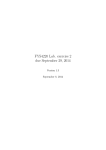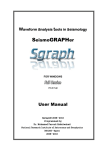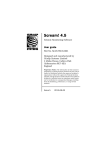Download AIMBAT User Manual Version 0.1.1
Transcript
AIMBAT User Manual Version 0.1.1 Xiaoting Lou1* 1 Department of Earth and Planetary Sciences, Northwestern University, Evanston, Illinois, USA * Email: [email protected] October 1, 2012 Contents 1 Introduction 2 2 Installation 3 2.1 2.2 Install Dependencies . . . . . . . . . . . . . . . . . . . . . . . . . . . . . . . 3 2.1.1 Mac . . . . . . . . . . . . . . . . . . . . . . . . . . . . . . . . . . . . 3 2.1.2 Linux . . . . . . . . . . . . . . . . . . . . . . . . . . . . . . . . . . . 4 Install pysmo.sac and pysmo.aimbat . . . . . . . . . . . . . . . . . . . . . . . 4 2.2.1 Install pysmo.sac . . . . . . . . . . . . . . . . . . . . . . . . . . . . . 5 2.2.2 Install pysmo.aimbat . . . . . . . . . . . . . . . . . . . . . . . . . . . 5 3 Tutorial 7 3.1 Parameter Configuration . . . . . . . . . . . . . . . . . . . . . . . . . . . . . 7 3.2 SAC Data Access . . . . . . . . . . . . . . . . . . . . . . . . . . . . . . . . . 8 3.2.1 Python Object for SAC Files . . . . . . . . . . . . . . . . . . . . . . 8 3.2.2 Python Pickle for SAC Files . . . . . . . . . . . . . . . . . . . . . . . 10 SAC Plotting and Phase Picking . . . . . . . . . . . . . . . . . . . . . . . . . 12 3.3.1 SAC Plotting . . . . . . . . . . . . . . . . . . . . . . . . . . . . . . . 13 3.3.2 SAC Phase Picking . . . . . . . . . . . . . . . . . . . . . . . . . . . . 16 Measuring Teleseismic Body Wave Arrival Times . . . . . . . . . . . . . . . 19 3.4.1 Automated Phase Alignment . . . . . . . . . . . . . . . . . . . . . . 19 3.4.2 Interactive Quality Control and Graphical User Interface . . . . . . . 21 3.3 3.4 4 Appendix 26 A List of Files and Directories in the Packages 26 1 1 Introduction AIMBAT (Automated and Interactive Measurement of Body wave Arrival Times) is an opensource software package for efficiently measuring teleseismic body wave arrival times for large seismic arrays (Lou et al., 2012). It is based on a widely used method called MCCC (MultiChannel Cross-Correlation) developed by VanDecar and Crosson (1990). The package is automated in the sense of initially aligning seismograms for MCCC which is achieved by an ICCS (Iterative Cross Correlation and Stack) algorithm. Meanwhile, a GUI (graphical user interface) is built to perform seismogram quality control interactively. Therefore, user processing time is reduced while valuable input from a user’s expertise is retained. As a byproduct, SAC (Goldstein et al., 2003) plotting and phase picking functionalities are replicated and enhanced. Modules and scripts included in the AIMBAT package were developed using Python programming language (http://www.python.org) and its open-source modules on the Mac OS X platform since 2009. The original MCCC code (VanDecar and Crosson, 1990) was transcribed into Python. The GUI of AIMBAT was inspired and initiated at the 2009 EarthScope USArray Data Processing and Analysis Short Course (http://www.iris.edu/ hq/es_course/). AIMBAT runs on Mac OS X, Linux/Unix and Windows thanks to the platform-independent feature of Python. It’s been tested on Mac OS 10.6.8 and 10.7 and Fedora 16. The AIMBAT software package is distributed under the GNU General Public License Version 3 (GPLv3) as published by the Free Software Foundation (http://www.gnu.org/licenses/ gpl.html). 2 2 2.1 Installation Install Dependencies The AIMBAT package depends on the standard libraries of Python 2.7 (http://docs. python.org/library/), including os, sys, ConfigParser(argparse), optparse, contextlib, pickle/cPickle, gzip, and bz2. AIMBAT also utilizes Numpy (http://numpy.scipy.org) and Scipy (http://scipy.org) for numerical array computation, and Matplotlib (Hunter , 2007) for 2-D plotting and GUI applications. These packages need to be installed before using AIMBAT. 2.1.1 Mac For Mac users, we recommend Macports (http://http://www.macports.org/) to install the dependent packages of AIMBAT. After installing Macports, run the following commands with superuser privilege: port port port port port port install install install install install install python27 py27-numpy py27-scipy py27-matplotlib py27-ipython python select Python 2.7 is thus installed to the <prefix> directory, which is /opt/local/Library/ Frameworks/Python.framework/Versions/2.7 for this case. Corresponding packages Numpy, Scipy and Matplotlib are installed to the global site-packages directory <prefix>/lib/ python2.7/site-packages. Installation of the last two packages are optional. ipython is an enhanced interactive Python shell. python select is used to select default Python version by the following command: port select --set python python27 3 2.1.2 Linux For Linux users, package management tools work similarly, such as yum on Red Hat/Fedora system: yum yum yum yum install install install install python.x86 64 numpy.x86 64 scipy.x86 64 python-matplotlib.x86 64 and aptitude on Debian system: aptitude aptitude aptitude aptitude install install install install python python-numpy python-scipy python-matplotlib The <prefix> directory is /usr. 2.2 Install pysmo.sac and pysmo.aimbat AIMBAT is released as a sub-package of pysmo in the name of pysmo.aimbat along with another sub-package pysmo.sac. The latest releases of pysmo.sac and pysmo.aimbat are available for download at both http://www.earth.northwestern.edu/~xlou/aimbat.html and github: https://github.com/pysmo/sac https://github.com/pysmo/aimbat Decompress the gzipped source tar balls in the directory where you want to install the packages (<pkg-install-dir>): tar zxvf pysmo-sac-0.5.tar.gz tar zxvf pysmo-aimbat-0.1.1.tar.gz 4 2.2.1 Install pysmo.sac Python module Distutils is used to write a setup.py script to easily build, distribute, and install pysmo.sac. In the directory <pkg-install-dir>/pysmo-sac-0.5, type python setup.py build python setup.py install to install it and its package information file pysmo.sac-0.5-py2.7.egg-info to the global site-packages directory <prefix>/lib/python2.7/site-packages, which is the same as Numpy, Scipy, and Matplotlib. If you don’t have write permission to the global site-packages directory, use the ”--user” option to install to <userbase>/lib/python2.7/site-packages: python setup.py install --user 2.2.2 Install pysmo.aimbat Three sub-directories are included in the <pkg-install-dir>/pysmo-aimbat-0.1.1 directory: example, scripts and src, which contain example SAC data files, Python scripts to run at command line, and Python modules to install, respectively. The core cross-correlation functions in pysmo.aimbat are written in both Python/Numpy (xcorr.py) and Fortran (xcorr.f90). Therefore, we need to use Numpy’s Distutils module for enhanced support of Fortran extension. The usage is similar to the standard Distutils. In the directory <pkg-install-dir>/pysmo-aimbat-0.1.1, type python setup.py build --fcompiler=gfortran python setup.py install to install the src directory to <prefix>/lib/python2.7/site-packages/pysmo/aimbat. Other Fortran compilers can be specified instead of gfortran. Add <pkg-install-dir>/pysmo-aimbat-0.1.1/scripts to environment variable PATH in a shell’s start-up file for command line execution of the scripts. Typically for Bash and C shell users, type 5 export PATH=$PATH:<pkg-install-dir>/pysmo-aimbat-0.1.1/scripts setenv PATH $PATH:<pkg-install-dir>/pysmo-aimbat-0.1.1/scripts in .bashrc and .cshrc files, respectively. To test the installation of the pysmo.sac and pysmo.aimbat packages, type from pysmo import sac from pysmo import aimbat in a Python shell. 6 3 3.1 Tutorial Parameter Configuration Matplotlib works with six GUI (Graphical User Interface) toolkits: WX, Tk, Qt(4), GTK, Fltk and macosx (http://matplotlib.org/contents.html). The GUI of AIMBAT utilizes GUI neutral widgets and GUI neutral event handling API (Application Programming Interface) to support interactive plotting (http://matplotlib.org/api/widgets_api.html, http://matplotlib.org/users/event_handling.html). Examples given in this manual are using the default toolkit Tk and backend TkAgg. See http://matplotlib.org/faq/ usage_faq.html#what-is-a-backend and http://matplotlib.org/users/customizing. html#customizing-matplotlib for explanation of the backend and how to customize it. In short, put the following line in your matplotlibrc file: backend : TkAgg #Agg rendering to a Tk canvas Other parameters for the package can be set up by a configuration file ttdefaults.conf, which is interpreted by the module ConfigParser. This configuration file is searched in the following order: (1) file ttdefaults.conf in the current working directory (2) file .aimbat/ttdefaults.conf in your HOME directory (3) a file specified by environment variable TTCONFIG (4) file ttdefaults.conf in the directory where AIMBAT is installed An example of the ttdefaults.conf file and its explanations are given in Table 1. Python scripts in the <pkg-install-dir>/pysmo-aimbat-0.1.1/scripts can be executed from the command line. The command line arguments are parsed by the optparse module to improve the scripts’ flexibility. If conflicts existed, the command line options override the default parameters given in the configuration file ttdefaults.conf. Run the scripts with the ”-h” option for the usage messages. 7 File ttdefaults.conf Description [sacplot] colorwave = blue colorwavedel = gray colortwfill = green colortwsele = red alphatwfill = 0.2 alphatwsele = 0.6 npick = 6 pickcolors = kmrcgyb pickstyles = – : figsize = 8 10 rectseis = 0.1 0.06 0.76 0.9 minspan = 5 srate = -1 Color of waveform Color of waveform which is deselected Color of time window fill Color of time window selection Transparency of time window fill Transparency of time window selection Number of time picks (plot picks: t0-t5) Colors of time picks Line styles of time picks (use second one if ran out of color) Figure size for plotphase.py Axes rectangle size within the figure Minimum sample points for SpanSelector to select time window Sample rate for loading SAC data. Read from first file if srate < 0 [sachdrs] twhdrs = user8 user9 ichdrs = t0 t1 t2 mchdrs = t2 t3 hdrsel = kuser0 qfactors = ccc snr coh qheaders = user0 user1 user2 qweights = 0.3333 0.3333 0.3333 SAC headers for time window beginning and ending SAC headers for ICCS time picks SAC headers for MCCC input and output time picks SAC header for seismogram selection status Quality factors: cross-correlation coefficient, signal-to-noise ratio, time domain coherence SAC Headers for quality factors Weights for quality factors [iccs] srate = -1 xcorr modu = xcorrf90 xcorr func = xcorr fast shift = 10 maxiter = 10 convepsi = 0.001 convtype = coef stackwgt = coef fstack = fstack.sac Sample rate for loading SAC data. Read from first file if srate < 0 Module for calculating cross-correlation: xcorr for Numpy or xcorrf90 for Fortran Function for calculating cross-correlation Sample shift for running coarse cross-correlation Maximum number of iteration Convergence criterion: epsilon Type of convergence criterion: coef for correlation coefficient, or resi for residual Weight each trace when calculating array stack SAC file name for the array stack [mccc] srate = -1 ofilename = mc xcorr modu = xcorrf90 xcorr func = xcorr faster shift = 10 extraweight = 1000. lsqr = nowe #lsqr = lnco #lsqr = lnre rcfile = .mcccrc evlist = event.list Sample rate for loading SAC data. Read from first file if srate < 0 Output file name of MCCC. Use ”$evdate.mc$phase” if mc Module for calculating cross-correlation: xcorr for Numpy or xcorrf90 for Fortran Function for calculating cross-correlation Sample shift for running coarse cross-correlation Weight for the zero-mean equation in MCCC weighted lsqr solution Type of lsqr solution: no weight Type of lsqr solution: weighted by correlation coefficient, solved by lapack Type of lsqr solution: weighted by residual, solved by lapack Configuration file for MCCC parameters (deprecated) File for event hypocenter and origin time (deprecated) [signal] tapertype = hanning taperwidth = 0.1 Taper type Taper width Table 1: Example of AIMBAT configuration file ttdefaults.conf. 3.2 3.2.1 SAC Data Access Python Object for SAC Files The pysmo.sac package is developed to read and write individual SAC files. The Python class sacfile of module sacio opens a SAC file and returns an object including data and all 8 SAC header variables as its attributes. Modifications of object attributes are saved to file. It is written purely in Python so that it also runs with Jython (http://www.jython.org). The <pkg-install-dir>/pysmo-aimbat-0.1.1/scripts/egsac.py script (Figure 1) gives a simple example to read, resample and plot a seismogram using pysmo, Scipy and Matplotlib. You can type the codes in a Python/iPython shell, or run as a script in the directory <pkg-install-dir>/pysmo-aimbat-0.1.1/example/Event_2011.09.15.19.31.04.080 (referred to as <example-event-dir> hereafter). Figure 1: The <pkg-install-dir>/pysmo-aimbat-0.1.1/scripts/egsac.py script which produces Figure 2. 9 In this example, a SAC file named TA.109C. .BHZ.sac is read in as a sacfile object. The time array is calculated from SAC headers. The data array is resampled from interval 0.025 to 2.0 seconds using Scipy’s signal processing module. Result is displayed in Figure 2. Add the following codes to write the resampled seismogram to file TA.109C. .BHZ.sac: sacobj.delta = deltanew sacobj.npts = nptsnew sacobj.data = y2 1e 5 1.5 1.0 Delta = 0.025 s Delta = 2.000 s TA.109C.__.BHZ.sac 0.5 0.0 0.5 1.0 600 650 700 750 Time [s] 800 850 900 Figure 2: Example of reading, resampling and plotting a SAC file. 3.2.2 Python Pickle for SAC Files The pysmo.sacio module converts SAC files to sacfile objects. Any modification of the objects are instantly written to files. In data processing, the user may want to abandon changes made earlier, which brings the need of a buffer for the sacfile objects. The SacDataHdrs class in the pysmo.aimbat.sacpickle module is written on top of pysmo.sacio to serves this purpose by reading a SAC file and returning a sacdh object that is very similar of the sacfile object. Essentially, the sacdh object is a copy of the the sacfile object in the memory, except that SAC headers ’t0-t9’, ’user0-user9’, ’kuser0-kuser2’ are saved in three Python lists. A gsac object of the SacGroup class consists of a group of sacdh objects from event-based SAC data files, earthquake hypocenter information and station locations. An additional step is required to save changes in the gsac object to files. In order to avoid frequent SAC file I/O, the pickle/cPickle module is used for serializing and de-serializing the gsac object structure. Thus the data processing efficiency is improved 10 because reading and writing of SAC files are done only once each before and after data processing. Script sac2pkl.py does the conversions between SAC files and Python pickles. Its usage message can be printed out by running ”sac2pkl.py -h” at command line and the result is displayed in Figure 3. For example, in the data example directory <exampleevent-dir>, run sac2pkl.py -s *Z -o 20110915.19310408.bhz.pkl -d 0.025 to read 163 vertical component seismograms at a sample interval of 0.025 s and convert to a gsac object which is saved in the pickle file 20110915.19310408.bhz.pkl. To save disk space, compressed pickle files in gz and bz2 formats can be generated by: sac2pkl.py -s *Z -o 20110915.19310408.bhz.pkl -d 0.025 -z gz sac2pkl.py -s *Z -o 20110915.19310408.bhz.pkl -d 0.025 -z bz2 at the cost of more CPU time. After processing, run sac2pkl.py 20110915.19310408.bhz.pkl -p to convert the pickle file to SAC files. Figure 3: Help message of the sac2pkl.py script. See the doc string of pysmo.aimbat.sacpickle (type ”from pysmo.aimbat import sacpickle; print sacpickle. doc ” in a Python shell) and http://docs.python.org/library/ pickle.html for more information about the Python data structure, pickling and unpickling. 11 3.3 SAC Plotting and Phase Picking SAC plotting and phase picking functionalities are replicated and enhanced based on the GUI neutral widgets (such as Button and SpanSelector) and the event (keyboard and mouse events such as key press event and mouse motion event) handling API of Matplotlib (Hunter , 2007). They are implemented in two modules pysmo.aimbat.plotphase and pysmo.aimbat.pickphase, which are used by corresponding scripts sacplot.py and sacppk.py executable at command line. Their help messages are displayed in Figures 4 and 5. Figure 4: Help message of the sacplot.py script. 12 Figure 5: Help message of the sacppk.py script. 3.3.1 SAC Plotting Options ”-i, -z, -d, -a, and -b” of sacplot.py set the seismogram plotting baseline as file index, zero, epicentral distance in degrees, azimuth, and back-azimuth, respectively. The user can run sacplot.py directly with the options, or run individual scripts sacp1.py, sacp2.py, sacprs.py, sacpaz.py, and sacpbaz.py which preset the baseline options and plot seismograms in SAC p1 style, p2 style, record section, and relative to azimuth and back-azimuth. The following commands are equivalent: sacplot.py -i ⇐⇒ sacp1.py 13 sacplot.py sacplot.py sacplot.py sacplot.py -z -d -a -b ⇐⇒ ⇐⇒ ⇐⇒ ⇐⇒ sacp2.py sacprs.py sacpaz.py sacpbaz.py Figure 6: The <pkg-install-dir>/pysmo-aimbat-0.1.1/scripts/egplot.py script which produces Figure 7. 14 Figure 7: Example of plotting multiple SAC files in (A) record section; (B) SAC p1 style; and (C) SAC p2 style. This figure is the random-color version of Figure 1 in Lou et al. (2012). 15 Input data files need to be supplied to the scripts in the form of either a list of SAC files or a pickle file which includes multiple SAC files. For example, a ”bhz.pkl” file is generated from 22 vertical component seismograms ”TA.[1-K]*Z” by running: sac2pkl.py TA.[1-K]*BHZ -o bhz.pkl -d0.025 in the data example directory <example-event-dir>. Then the two commands are equivalent: sacp1.py TA.[1-K]*Z ⇐⇒ sacp1.py bhz.pkl For large number of seismograms, the pickle file is suggested because of faster loading. Besides using the standard sacplot.py script, the user can modify its getAxes function in your own script to customize figure size and axes attributes. Script egplot.py (Figure 6) is such an example in which SAC p1, p2 styles and record section plotting are drawn in three axes in the same figure canvas. Run egplot.py TA.[1-K]*Z -f1 -C at command line to produce Figure 7. The ”-C” option uses random color for each seismogram. The ”-f1” option fills the positive signals of waveform with less transparency. In the script, ”opts.ynorm” sets the waveform normalization and ”opts.reltime=0” sets the time axis relative to time pick t0. An improvement over SAC is that the program outputs the filename when the seismogram is clicked on by the mouse. This is enabled by the event handling API and is mostly introduced for use in SAC p2 style plotting when seismograms are plotted on top of each other. It is especially useful when a large number of seismograms create difficulties in labeling. Another improvement is easier window zooming enabled by the SpanSelector widget and the event handling API. Select a time span by mouse clicking and dragging to zoom in a waveform section. Press the ’z’ key to zoom out to the previous time range. 3.3.2 SAC Phase Picking SAC plotting (pysmo.aimbat.plotphase) does not involve change in data files but phase picking (pysmo.aimbat.pickphase) does. A GUI is built for user to interactively pick phase arrival times. Figure 8 is an example screen shot running 16 sacppk.py 20110915.19310408.bhz.pkl -w in the data example directory <example-event-dir>. Figure 8: Screen shot of running ”sacppk.py 20110915.19310408.bhz.pkl -w”. First 25 out 162 selected seismograms and 1 deleted seismogram are plotted on the first page. Click the Prev and Next Buttons to navigate through the total 6 pages. Following SAC convention, the user can set a time pick by pressing the ’t’ key and number keys ’0-9’. The x location of the mouse position is saved to corresponding SAC headers ’t0-t9’. Time window zooming in pysmo.aimbat.pickphase is implemented in the same way as in pysmo.aimbat.plotphase to replace SAC’s combination of the ’x’ key and mouse click. Zooming out key is set to ’z’ because the ’o’ key is used for another purpose by Matplotlib. The filename printing out by mouse clicking feature is also available in pysmo.aimbat.pickphase. 17 A major improvement over SAC is picking a time window in addition to time picks. Pressing the ’w’ key to save the current time axis range to two user-defined SAC header variables. A transparent green span is plotted within the time window (Figure 8). Another major improvement involves quality control with convenient operations to (de)select seismograms. In the GUI in Figure 8, there are two divisions of selected and deleted seismograms. Selected seismograms with a positive trace number are displayed with blue wiggles, while deleted seismograms with negative trace numbers are plotted in gray. The user can simply click on a certain seismogram to switch the selection status, either to exclude it or bring it back for inclusion. The trace selection status is stored in a user-defined SAC header variable. In SAC, command ”ppk p 10” plots 10 seismograms on each page. Pressing the ’b’ and ’n’ keys to navigate through pages. The number of seismograms plotted on each page is controlled by command line option ”-m maxsel maxdel” for sacppk.py. The Prev and Next Buttons are for page navigation and the Save Button saves the change in time picks and time window to files. The default values for maxsel and maxdel are 25 and 5, which means a maximum of 30 seismograms on each page. In Figure 8, there are 26 seismograms on the first page because only 1 seismogram is deleted. On next page, there are 30 selected seismograms. To plot 50 seismograms on each page, run sacppk.py 20110915.19310408.bhz.pkl -w -m 45 5 and there would be 4 total pages and 13 seismograms on the last page. To plot seismograms relative to time pick t0 and fill the positive and negative wiggles of waveform, run sacppk.py 20110915.19310408.bhz.pkl -w -r0 -f1 To sort seismograms by epicentral distance in increase and decrease orders, run sacppk.py 20110915.19310408.bhz.pkl -w -sdist sacppk.py 20110915.19310408.bhz.pkl -w -sdistSorting by azimuth and back-azimuth is similar: sacppk.py 20110915.19310408.bhz.pkl -w -saz sacppk.py 20110915.19310408.bhz.pkl -w -sbaz 18 3.4 Measuring Teleseismic Body Wave Arrival Times The core idea in using AIMBAT to measure teleseismic body wave arrival times has two parts: automated phase alignment and interactive quality control. The first part reduces user processing time and the second part retains valuable user inputs. 3.4.1 Automated Phase Alignment The ICCS algorithm calculates an array stack from predicted time picks, cross-correlates each seismogram with the array stack to find the time lags at maximum cross-correlation, then use the new time picks to update the array stack in an iterative process. The MCCC algorithm cross-correlates each possible pair of seismograms and uses a least-squares method to calculate an optimized set of relative arrival times. Our method is to combine ICCS and Figure 9: Help message of the iccs.py script. 19 MCCC in a four-step procedure using four anchoring time picks 0 Ti , 1 Ti , 2 Ti , and 3 Ti : (a) Coarse alignment by ICCS (b) Pick phase arrival at the array stack (c) Refined alignment by ICCS (d) Final alignment by MCCC The input and output time picks for the steps (a), (c) and (d) and their corresponding SAC headers are listed in Table 2. The one-time manual phase picking at the array stack in step (b) allows the measurement of absolute arrival times. The detailed methodology and procedure can be found in Lou et al. (2012). Figure 10: Help message of the mccc.py script. 20 Input Step (a) (c) (d) Output Algorithm Time Window Time Pick Time Header Time Pick Time Header Wa Wb Wb 0 Ti 0 2 Ti T0 T2 T2 1 Ti T1 T2 T3 ICCS ICCS MCCC 2 Ti 2 Ti 3 Ti Table 2: Time picks and their SAC headers used in the procedure for measuring teleseismic body wave arrival times. The ICCS and MCCC algorithms are implemented in two modules pysmo.aimbat.algiccs and pysmo.aimbat.algmccc, and can be executed in scripts iccs.py and mccc.py, respectively. Usages are displayed in Figures 9 and 10. 3.4.2 Interactive Quality Control and Graphical User Interface In practical data processing, there is a constant need of seismogram quality control, which is mixed with the procedure described above. ICCS steps (a), (b), and (c) are likely to be applied multiple times after removing low quality seismograms. To facilitate quality control, ICCS calculates three quality factors for each seismogram: cross-correlation coefficient (CCC), signal-to-noise ratio (SNR), and time domain coherence (COH). The ”-a” and ”A” modes of iccs.py can remove seismograms with low qualities and rerun ICCS until all seismograms meet the minimum requirements specified by the ”-q” option. A GUI is also designed to run both ICCS and MCCC and perform interactive quality control. It is implemented in module pysmo.aimbat.qualctrl and script ttpick.py based on pysmo.aimbat.pickphase and four Buttons for the four-step procedure. The quality control operation is the same as sacppk.py. The user can interactively switch the selection status of a seismogram by mouse clicking on the waveform. In order to efficiently delete low quality seismograms, different attributes listed below are used as sorting criteria: • -s 0: sort by user-defined weighted-average of CCC, SNR and COH • -s 1: sort by CCC • -s 2: sort by SNR • -s 3: sort by COH • -s t: sort by time pick difference • -s az: sort by azimuth 21 • -s baz: sort by back-azimuth • -s dist: sort by epicentral distance Other SAC headers also work with the ”-s” option. Default sorting order is increase. Append ”-” to make it decrease order, such as ”-s t-”. Sorting by time pick difference (2 Ti − 0 Ti ) in both increase and decrease orders are useful in detecting cycle-skipping. Figure 11: Help message of the ttpick.py script. 22 To start the GUI, run ttpick.py 20110915.19310408.bhz.pkl -t -10 10 -s1 in the data example directory <example-event-dir> and the screen shot is displayed in Figure 12. The ”-t -10 10” option specifies an initial time window of (-10,10) seconds around the initial time pick to run ICCS. More screen shots along the data processing workflow are shown in Figures 13-16. See the captions for commands and descriptions. Figure 12: Screen shot of data processing initiated by running command "ttpick.py 20110915.19310408.bhz.pkl -t -10 10 -s1 -x -30 30". Initial time window Wa = (−10, 10) s. The ”-x -30 30” option sets the time axis range to be (-30, 30) s. Seismograms are sorted by CCC. 23 Figure 13: (A) Delete station UW.WOOD and rerun ICCS step (a) by clicking the ICCS-A Button. (B) Pick phase emergence on the array stack for measuring absolute arrival times. Choose a smaller time window Wb = (−2.7, 2.9) s for refined alignment. Click the Sync Button to get 2 Ti0 and time window for each seismogram. Figure 14: (A) Run ICCS step (c) by clicking the ICCS-B Button. Relative time pick is changed from T1 to T2. (B) Quit GUI and restart with "ttpick.py 20110915.19310408.bhz.pkl -x -20 20 -r2 -s0" which sorts seismograms by weightedaverage of three quality factors. 24 Figure 15: (A) Sort seismograms by time pick difference in increase order by running "ttpick.py 20110915.19310408.bhz.pkl -x -10 10 -r2 -st". (B) Sort seismograms by time pick difference in decrease order by running "ttpick.py 20110915.19310408.bhz.pkl -x -10 10 -r2 -st-" Figure 16: (A) Run MCCC by clicking the MCCC Button. Relative time pick is changed from T2 to T3. (B) Sort seismograms by time pick difference in decrease order by running "ttpick.py 20110915.19310408.bhz.pkl -x -10 10 -r3 -sdist". 25 4 Appendix A List of Files and Directories in the Packages pysmo.sac: xcorr.py xcorrf.90 xcorrf90.so scripts/ egalign1.py egalign2.py egplot.py egsac.py iccs.py mccc.py sac2pkl.py sacp1.py sacp2.py sacpaz.py sacpbaz.py sacplot.py sacppk.py sacprs.py ttpick.py example/Event 2011.09.15.19.31.04.08/ setup.py src/pysmo/sac sacio.py sacfunc.py sacmeth.py pysmo.aimbat: setup.py src/pysmo/aimbat algiccs.py algmccc.py pickphase.py plotphase.py plotutils.py qualctrl.py qualsort.py sacpickle.py ttconfig.py ttdefaults.conf 26 References Goldstein, P., D. Dodge, M. Firpo, and L. Minner (2003), SAC2000: Signal processing and analysis tools for seismologists and engineers, International Geophysics, 81, 1613–1614. Hunter, J. (2007), Matplotlib: A 2D Graphics Environment, Computing in Science & Engineering, 3 (9), 90–95. Lou, X., S. van der Lee, and S. Lloyd (2012), A Python/Matplotlib Tool for Measuring Teleseismic Body Wave Arrival Times, Seismological Research Letters, in revision. VanDecar, J. C., and R. S. Crosson (1990), Determination of teleseismic relative phase arrival times using multi-channel cross-correlation and least squares, Bulletin of the Seismological Society of America, 80 (1), 150–169. 27
































